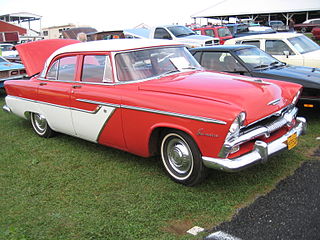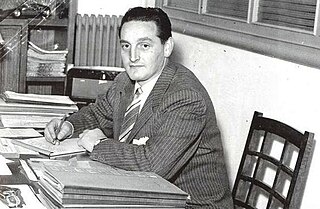Dodge is an American brand of automobiles and a division of Stellantis North America, based in Auburn Hills, Michigan. Dodge vehicles have historically included performance cars, and for much of its existence Dodge was Chrysler's mid-priced brand above Plymouth.

Plymouth was a brand of automobiles produced by Chrysler Corporation and its successor DaimlerChrysler. The brand was launched in 1928 to compete in what was then described as the "low-priced" market segment that was dominated by Chevrolet and Ford. It became a high-volume seller for the automaker until the late 1990s. Plymouth cars were marketed primarily in the United States. The brand was withdrawn from the marketplace in 2001. The Plymouth models that were produced up to then were either discontinued or rebranded as Chrysler or Dodge.

Virgil Max "Ex" Exner Sr. was an automobile designer for several American automobile companies, most notably Chrysler and Studebaker.

The Plymouth Valiant is an automobile which was marketed by the Plymouth division of the Chrysler Corporation in the United States from the model years of 1960 through 1976. It was created to give the company an entry in the compact car market emerging in the late 1950s. The Valiant was also built and marketed, without the Plymouth brand, worldwide in countries including Argentina, Australia, Brazil, Canada, Finland, Mexico, New Zealand, South Africa, Sweden and Switzerland, as well as other countries in South America and Western Europe. It became well known for its excellent durability and reliability, and was one of Chrysler's best-selling automobiles during the 1960s and 1970s, helping to keep the company solvent during an economic downturn.

The Dodge Omni and the nearly identical badge engineered variant, the Plymouth Horizon, is a subcompact car manufactured and marketed by Chrysler Corporation for model years 1978-1990. The first Chrysler model line produced with front-wheel drive, the Omni and Horizon were also the first front-wheel drive economy cars assembled in the United States. Marketed for eleven years with very few changes, around 2,500,000 Omnis and Horizons were manufactured, with the Plymouth variants more popular than the Dodge-branded models.

The LH platform served as the basis for the Chrysler Concorde, Chrysler LHS, Chrysler 300M, Dodge Intrepid, Eagle Vision, and the final Chrysler New Yorker. A Plymouth to be called the "Accolade" was planned, but never saw production. The platform pioneered Chrysler's "cab-forward" design; featured on some Chrysler, Dodge, and Eagle cars in the 1990s and early 2000s.

The tailfin era of automobile styling encompassed the 1950s and 1960s, peaking between 1955 and 1961. It was a style that spread worldwide, as car designers picked up styling trends from the US automobile industry, where it was regarded as the "golden age" of American auto design and American exceptionalism.

The Plymouth Prowler, later the Chrysler Prowler, is a retro-styled production sports car manufactured and marketed from 1997 to 2002 by DaimlerChrysler, based on the 1993 concept car of the same name.
Freeman Thomas is an American automobile and industrial designer who has worked for Porsche, Volkswagen Group, DaimlerChrysler and Ford.

Automotive design is the process of developing the appearance of motor vehicles, including automobiles, motorcycles, trucks, buses, coaches, and vans.

Ralph Victor Gilles is a Canadian-American automobile designer and executive, and current Chief Design Officer of Stellantis NV. His career started in 1992, where he joined Chrysler. During his time at Chrysler, he was responsible for designing the North American Car of the Year-winning 2005 Chrysler 300, as well as led the design team that created the 2013 SRT Dodge Viper. Gilles was the president and CEO of Chrysler's SRT brand and senior vice president of design at Chrysler before being promoted to head of design for Fiat Chrysler Automobiles in April 2015. Following FCA's merger with PSA Group forming the Stellantis group in 2021, he was appointed the Chief Design Officer of the newly merged company.

The Chrysler Falcon is a two-seat roadster concept car commissioned by Chrysler and built by Carrozzeria Ghia for the 1955 model year. The car was never put into production, but some of its features reappeared on later Chrysler designs.

François J. Castaing was a French automotive executive with Renault, American Motors, and Chrysler. He was an engineering graduate from École Nationale Supérieure d'Arts et Métiers in Paris, and worked in Europe for Gordini and Renault before being named vice president for Product Engineering and Development at American Motors Corporation (AMC).

Luigi "Gigi" Segre was an Italian automotive designer noted for his business and engineering acumen during his stewardship and ownership of Carrozzeria Ghia (1953–63), one of an Italy's premier automobile design and coachbuilders.
Alexander Sarantos Tremulis was a Greek-American industrial designer in the North American automotive industry. Tremulis held automotive design positions at Cord Automobile, Duesenberg, General Motors, Tucker Car Corporation and Ford Motor Company before establishing a consulting firm.

John Eric Herlitz was an American industrialist most commonly known for his styling of cars at Chrysler Corporation, particularly the Plymouth Barracuda production car and Dodge Copperhead concept car.

The history of Chrysler involves engineering innovations, high finance, wide alternations of profits and losses, various mergers and acquisitions, and multinationalization. Chrysler, a large automobile manufacturer, was founded in the 1920s and continues under the name Stellantis North America.

Owen Ray Skelton was an American automotive industry engineer and automobile designer. Along with Fred M. Zeder and Carl Breer, he was one of the core group who formed the present day Chrysler Corporation. He made material contributions to Tourist Automobile Company, Allis-Chalmers, Studebaker, and was the main engineer behind the Chrysler Airflow automobile. He was elected to the Automotive Hall of Fame in 2002.

The Three Musketeers is a nickname given to a team of three Studebaker engineers, Frederick Morrell Zeder, Owen Ray Skelton, and Carl Breer. They would become instrumental in the founding of the Chrysler Corporation, and were hand-picked by Walter Chrysler to come with him when he started the new company.
William Robinson was an American automobile designer for numerous American companies, notably Chrysler as creative designer from 1948 to 1980 and Briggs Manufacturing Company. In a second career, Robinson taught design for twenty-two years at the College of Creative Studies.


















